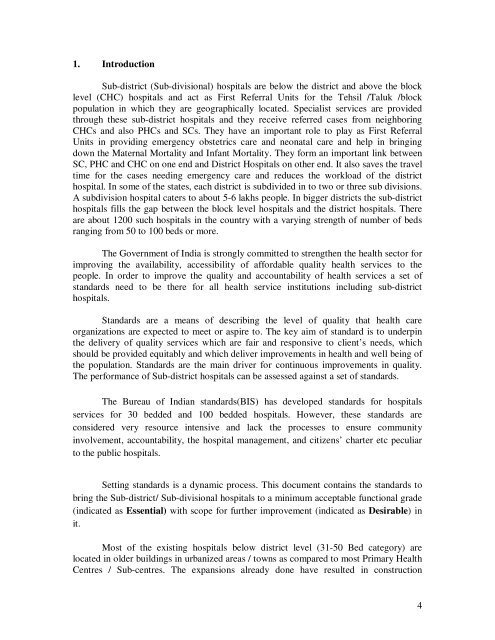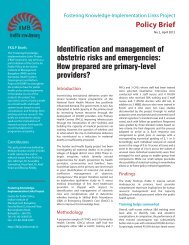Modifications in the updated Sub Divisional Hospital (SDH) 51 ... - IIMB
Modifications in the updated Sub Divisional Hospital (SDH) 51 ... - IIMB
Modifications in the updated Sub Divisional Hospital (SDH) 51 ... - IIMB
You also want an ePaper? Increase the reach of your titles
YUMPU automatically turns print PDFs into web optimized ePapers that Google loves.
1. Introduction<br />
<strong>Sub</strong>-district (<strong>Sub</strong>-divisional) hospitals are below <strong>the</strong> district and above <strong>the</strong> block<br />
level (CHC) hospitals and act as First Referral Units for <strong>the</strong> Tehsil /Taluk /block<br />
population <strong>in</strong> which <strong>the</strong>y are geographically located. Specialist services are provided<br />
through <strong>the</strong>se sub-district hospitals and <strong>the</strong>y receive referred cases from neighbor<strong>in</strong>g<br />
CHCs and also PHCs and SCs. They have an important role to play as First Referral<br />
Units <strong>in</strong> provid<strong>in</strong>g emergency obstetrics care and neonatal care and help <strong>in</strong> br<strong>in</strong>g<strong>in</strong>g<br />
down <strong>the</strong> Maternal Mortality and Infant Mortality. They form an important l<strong>in</strong>k between<br />
SC, PHC and CHC on one end and District <strong>Hospital</strong>s on o<strong>the</strong>r end. It also saves <strong>the</strong> travel<br />
time for <strong>the</strong> cases need<strong>in</strong>g emergency care and reduces <strong>the</strong> workload of <strong>the</strong> district<br />
hospital. In some of <strong>the</strong> states, each district is subdivided <strong>in</strong> to two or three sub divisions.<br />
A subdivision hospital caters to about 5-6 lakhs people. In bigger districts <strong>the</strong> sub-district<br />
hospitals fills <strong>the</strong> gap between <strong>the</strong> block level hospitals and <strong>the</strong> district hospitals. There<br />
are about 1200 such hospitals <strong>in</strong> <strong>the</strong> country with a vary<strong>in</strong>g strength of number of beds<br />
rang<strong>in</strong>g from 50 to 100 beds or more.<br />
The Government of India is strongly committed to streng<strong>the</strong>n <strong>the</strong> health sector for<br />
improv<strong>in</strong>g <strong>the</strong> availability, accessibility of affordable quality health services to <strong>the</strong><br />
people. In order to improve <strong>the</strong> quality and accountability of health services a set of<br />
standards need to be <strong>the</strong>re for all health service <strong>in</strong>stitutions <strong>in</strong>clud<strong>in</strong>g sub-district<br />
hospitals.<br />
Standards are a means of describ<strong>in</strong>g <strong>the</strong> level of quality that health care<br />
organizations are expected to meet or aspire to. The key aim of standard is to underp<strong>in</strong><br />
<strong>the</strong> delivery of quality services which are fair and responsive to client’s needs, which<br />
should be provided equitably and which deliver improvements <strong>in</strong> health and well be<strong>in</strong>g of<br />
<strong>the</strong> population. Standards are <strong>the</strong> ma<strong>in</strong> driver for cont<strong>in</strong>uous improvements <strong>in</strong> quality.<br />
The performance of <strong>Sub</strong>-district hospitals can be assessed aga<strong>in</strong>st a set of standards.<br />
The Bureau of Indian standards(BIS) has developed standards for hospitals<br />
services for 30 bedded and 100 bedded hospitals. However, <strong>the</strong>se standards are<br />
considered very resource <strong>in</strong>tensive and lack <strong>the</strong> processes to ensure community<br />
<strong>in</strong>volvement, accountability, <strong>the</strong> hospital management, and citizens’ charter etc peculiar<br />
to <strong>the</strong> public hospitals.<br />
Sett<strong>in</strong>g standards is a dynamic process. This document conta<strong>in</strong>s <strong>the</strong> standards to<br />
br<strong>in</strong>g <strong>the</strong> <strong>Sub</strong>-district/ <strong>Sub</strong>-divisional hospitals to a m<strong>in</strong>imum acceptable functional grade<br />
(<strong>in</strong>dicated as Essential) with scope for fur<strong>the</strong>r improvement (<strong>in</strong>dicated as Desirable) <strong>in</strong><br />
it.<br />
Most of <strong>the</strong> exist<strong>in</strong>g hospitals below district level (31-50 Bed category) are<br />
located <strong>in</strong> older build<strong>in</strong>gs <strong>in</strong> urbanized areas / towns as compared to most Primary Health<br />
Centres / <strong>Sub</strong>-centres. The expansions already done have resulted <strong>in</strong> construction<br />
4




